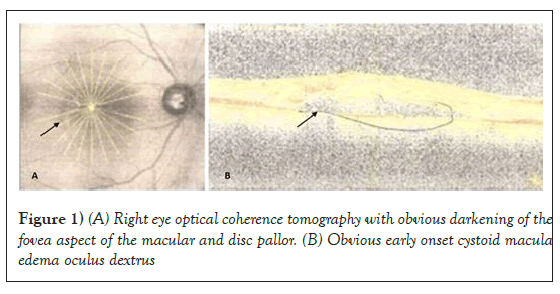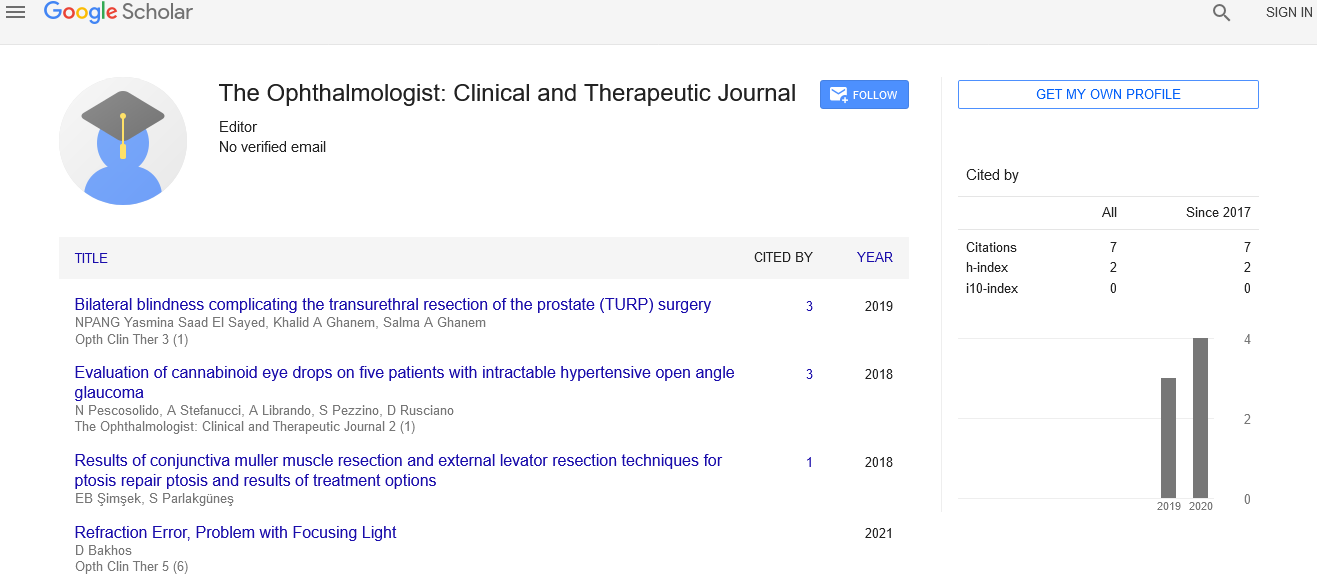Treatment of vogt koyanagi harada disease
2 Department of Opthalmology, Prince Mutaib Bin Abdulaziz Hospital, Sakaka, Saudi Arabia, Email: akinwaleakinfe4@gmail.com
Received: 29-Jul-2020 Accepted Date: Aug 10, 2020; Published: 17-Aug-2020
Citation: Alaql MK, Akinfe AA, Al-Nour MK. Treatment of vogt-koyanagi-harada disease. Opth Clin Ther. 2020;4(3):5-6.
This open-access article is distributed under the terms of the Creative Commons Attribution Non-Commercial License (CC BY-NC) (http://creativecommons.org/licenses/by-nc/4.0/), which permits reuse, distribution and reproduction of the article, provided that the original work is properly cited and the reuse is restricted to noncommercial purposes. For commercial reuse, contact reprints@pulsus.com
Abstract
Vogt-Koyanagi-Harada (VKH) disease is a T-cell-mediated autoimmune inflammatory disease characterized by granulomatous panuveitis with a variety of other systemic manifestations. A 29-year-old man referred with a two-week history of pain, redness, photophobia, and blurring of vision of the right eye. The patient reported a history of tinnitus and vertigo. Ocular examination revealed that the visual acuity was hand movement Oculus Dextrus (OD) and 1.0 Oculus Sinister (OS), slight periocular depigmentation in the right eye, iris bombe in the right eye, sunset glow sign similar to Dalen-Fuchs nodules of multifocal choroiditis in the right eye, reduced fovea reflex/ subtle macular edema in the right eye, and normal anterior and posterior segment OS. The patient underwent a series of investigations and treatments, including corticosteroids, cyclosporine, antibiotics, and other local eye drugs. Surgical treatment included scheduling intravitreal ranibizumab for the right eye. Outcomes included improved general health conditions and improved visual condition (visual acuity improved to 0.8 OD). The combined therapy of immunosuppressive drugs with steroids was effective in improving visual impairment.
Keywords
Autoimmune; Uveitis; Systemic; Granulomatous.
Introduction
Vogt-Koyanagi-Harada (VKH) disease is an autoimmune inflammatory disorder that affects multiple systems with ocular, auditory, skin, and neurologic involvement [1]. It was described independently by Vogt, Koyanagi, and Harada as bilateral uveitis, exudative retinal detachments, integumentary disorders, and neurologic abnormalities [2]. Although uncommon, VKH represents 7% to 8% of patients with uveitis in Japan [3]. It is more common in Asian, Middle Eastern, Hispanic, and Native American populations [4]. An immuno-genetic predisposition that is common in certain ethnic groups is more likely to be associated with VKH. The age of onset has ranged from 3 to 89 years, as studies reported, but the highest frequency was in people in their fourth decade of life [5,6].
Gender plays a role in the epidemiology of VKH. Women are twice as likely to be affected by VKH than men [7,8]. However, some other authors found that gender is not a risk factor for VKH [9,10]. We present a rare case of VKH disease illustrating that the combined therapy of immunosuppressive drugs with steroids was effective in improving the visual impairment.
Case Study
A 26-year-old man was referred with a two-week history of pain, redness, photophobia, and blurring of vision of the right eye. There was associated history of tinnitus and vertigo. There was no history suggestive of meningismus; however, there was malaise, fever, headache, nausea, abdominal pain, but no stiffness of the neck or back. There was slight periocular vitiligo, but no poliosis. There was no history of joint pain, and no history of oral or genital ulceration. There was no backache and no history of cough, night sweats, or chest pain. There was no prior history of ocular injury and no previous eye surgery. The patient was neither diabetic nor hypertensive. The review of systems was not contributory.
On general and systemic examination, there was no acute distress, and the man’s blood pressure was 131/68 mmHg. His pulse rate was 78 beats per minute. An ocular examination revealed that the visual acuity was hand movement Oculus Dextrus (OD) and 1.0 Oculus Sinister (OS), with a slight periocular depigmentation in the right eye, and ciliary injection in the right eye.
Applanation tonometry revealed 14 mmHg OD/16 mmHg OS. The examination also detected multiple moderate keratic precipitates in the right eye, moderate depth anterior chamber in the right eye, iris bombe in the right eye, posterior synechia with almost seclusio pupillae in the right eye, slight cortical opacities and clear vitreous in the right eye, sunset glow sign similar to Dalen-Fuchs nodules of multifocal choroiditis in the right eye, reduced fovea reflex/subtle macular edema in the right eye, and normal anterior and posterior segment OS. The patient was admitted for proper evaluation and treatment with a multidisciplinary approach form of management.
Investigations included complete blood count, erythrocyte sedimentation rate, C-reactive protein, Mantoux test, venereal disease research laboratory, serial anterior segment photography, B-scan ultrasonography OD, brain computed tomography, orbit, and sinus with contrast, lumbar puncture for Cerebro Spinal Fluid (CSF) pleocytosis, computerized visual field, optical coherence tomography, fundus fluorescein angiography/indocyanine green, and an electroretinogram.
Treatment aimed to minimize the patient’s symptoms and save his eyesight through suppression of the ciliary spasm resulting in photophobia OD, suppression of the anterior segment inflammation OD, adhesiolysis OD, and treatment of macular edema and features suggestive of choroiditis. Medical treatment included intravenous (IV) methylprednisolone 1 g in 250 ml saline given over 30 minutes per day for three days and then tablet prednisolone 15 mg three times per day for three days, 10 mg three times per day for three days, and 5 mg three times per day for three days; IV ceftriaxone 1 g every 12 hours for three days, IV metronidazole 500 mg every eight hours for three days, IV omeprazole 40 mg daily for three days, Gutt prednisolone forte every two hours OD for seven days, Gutt Vigamox every four hours OD for seven days, Gutt Ocugesic every six hours OD for seven days, Gutt cyclosporines 0.05% (Restasis) every eight hours OD for seven days, and Gutt atropine every 12 hours OD for seven days.
Surgical treatment included an intravitreal ranibizumab injection for the right eye after obtaining informed consent for an intravitreal anti-vascular endothelial growth factor injection for the right eye (Figure 1). Outcomes included improved general health and improved visual conditions (visual acuity improved to 0.8 OD).
Discussion
TVKH disease is characterized by bilateral uveitis as the most common initial manifestation with red eyes, blurred vision, and pain. This is usually accompanied by systemic symptoms. Auditory symptoms include vertigo, tinnitus, and deficient hearing. Neurologic symptoms include meningeal irritation and involve headache, stiffness of the neck and back, meningitis, CSF pleocytosis, cranial nerve palsies, hemiparesis, transverse myelitis, and ciliary ganglionitis. Cutaneous manifestations include poliosis, vitiligo, and alopecia. The vitiligo often is found in the sacral region [2].
The broad spectrum of symptoms found in VKH suggests that there is a central mechanism involved in the multi-systemic manifestations. Currently, VKH is believed to be a T-cell-mediated autoimmune disease [11]. An antigenic component present in dermal, uveal, and meningeal melanocytes seems to be directing an autoimmune reaction. More evidence suggesting that VKH is an autoimmune disease is its association with other autoimmune disorders. These include Hashimoto thyroiditis, autoimmune polyglandular syndrome, immunoglobulin A nephropathy, and Guillain-Barré syndrome [12-15].
Clinically, VKH can be divided into four stages: prodromal, acute uveitic, convalescent, and chronic recurrent [16]. In the prodromal phase, symptoms may mimic a viral infection presented with flu-like symptoms that lasts for a few days [17]. The acute uveitic stage occurs within three to five days of the first stage as patients may experience blurred vision in both eyes due to diffuse choroiditis [17]. The convalescent stage usually follows a few months later. At this stage, depigmentation of the integument and choroid occurs [18]. The chronic stage may develop by interrupting the convalescent stage in 17% to 73% of patients [16,17]. Ocular complications such as cataract, choroidal neovascularization, glaucoma, and retinal fibrosis can be observed in this stage [18].
This patient’s visual prognosis is generally good with prompt diagnosis and aggressive immuno-modulatory treatment. Response of the inner ear to corticosteroids take one to four months and can give complete improvement of hearing, but corticosteroids cannot guard against effects on the eye, and it may lead to cataract, glaucoma, and optic atrophy.
Conclusion
In this rare case of VKH disease, the combined therapy of immunosuppressive drugs with steroids was effective in improving our patient’s visual impairment. A holistic, multidisciplinary approach to health care is warranted to optimize patient outcomes.
Financial support and sponsorship
Nil
Conflicts of Interest
There is no conflict of interest.
REFERENCES
- Andreoli CM, Stephen Foster C. Vogt-Koyanagi-Harada disease. Int Ophthalmol Clin. 2006; 46:111-122.
- Baltmr A, Lightman S, Tomkins-Netzer O. Vogt-Koyanagi-Harada syndrome: current perspectives. Clin Ophthalmol. 2016; 10:2345-2361.
- Lodhi SA, Reddy JL, Peram V. Clinical spectrum and management options in Vogt-Koyanagi-Harada disease. Clin Ophthalmol. 2017; 11:1399-1406.
- Ohguro N, Sonoda K-H, Takeuchi M, et al. The 2009 prospective multi-center epidemiologic survey of uveitis in Japan. Jpn J Ophthalmol. 2012; 56:432-435.
- Rathinam SR, Vijayalakshmi P, Namperumalsamy P, et al. Vogt-Koyanagi-Harada syndrome in children. Ocul Immunol Inflamm. 1998; 6:155-161.
- Martin TD, Rathinam SR, Cunningham ET. Prevalence, clinical characteristics, and causes of vision loss in children with Vogt-Koyanagi-Harada disease in South India. Retina. 2010; 30:1113-1121.
- Lertsumitkul S, Whitcup SM, Nussenblatt RB, et al. Subretinal fibrosis and choroidal neovascularization in Vogt-Koyanagi-Harada syndrome. Graefes Arch Clin Exp Ophthalmol. 1999; 237:1039-1045.
- Moorthy RS, Inomata H, Rao NA. Vogt-Koyanagi-Harada syndrome. Surv Ophthalmol 1995;39:265-292.
- Meng Q, Liu X, Yang P, et al. PDCD1 genes may protect against extraocular manifestations in Chinese Han patients with Vogt-Koyanagi-Harada syndrome. Mol Vis. 2009; 15:386-392.
- Hu K, Yang P, Jiang Z, et al. STAT4 polymorphism in a Chinese Han population with Vogt-Koyanagi-Harada syndrome and Behçet’s disease. Hum Immunol. 2010; 71:723-726
- Wang Y, Chan C-C. Gender differences in Vogt-Koyanagi-Harada disease and sympathetic ophthalmia. J Ophthalmol. 2014; 2014:1-8.
- Suzuki H, Isaka M, Suzuki S. Type 1 diabetes mellitus associated with Graves’ disease and Vogt-Koyanagi-Harada syndrome. Intern Med. 2008; 47:1241-1244.
- Kluger N, Mura F, Guillot B, et al. Vogt-Koyanagi-Harada syndrome associated with psoriasis and autoimmune thyroid disease. Acta Derm Venereol. 2008; 88:397-398.
- Matsuo T, Masuda I, Ota K, et al. Vogt-Koyanagi-Harada syndrome in two patients with immunoglobulin A nephropathy. Acta Med Okayama. 2007; 61:305-309.
- Najman-Vainer J, Levinson RD, Graves MC, et al. An association between Vogt-Koyanagi-Harada disease and Guillain-Barré syndrome. Am J Ophthalmol. 2001; 131:615-619.
- Cunningham ET, Rathinam SR, Tugal-Tutkun I, et al. Vogt-Koyanagi-Harada disease. Ocul Immunol Inflamm. 2014; 22:249-52.
- Rao NA, Gupta A, Dustin L, et al. Frequency of distinguishing clinical features in Vogt-Koyanagi-Harada disease. Ophthalmology. 2010; 117:591-599.
- Inomata H, Rao NA. Depigmented atrophic lesions in sunset glow fundi of Vogt-Koyanagi-Harada disease. Am J Ophthalmol. 2001; 131:607-614.






